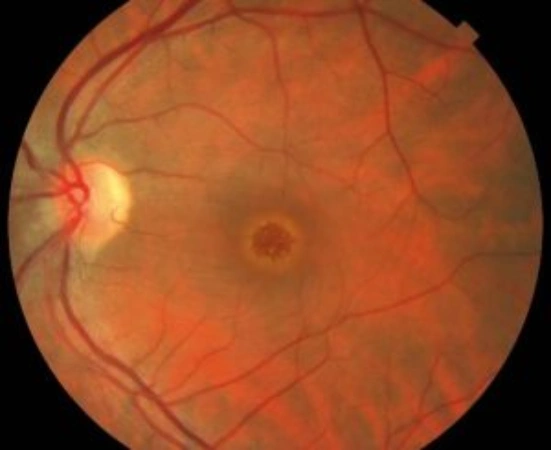A macular hole is a defect or tear of tissue located in the central area of the macula that causes a central vision defect (scotoma) or a blurred area of vision in the center of the visual field.
The main cause is pathological adhesion of the vitreous gel on the foveal area associated with secondary traction that produces the hole.
The main risk factor is age. Others include myopia, ocular trauma, or a history of macular hole in the fellow eye.
Pathologies and Treatments

Symptoms
The symptoms related to a macular hole begin gradually. In the initial stages, vision may appear slightly distorted or a haze may be noticed in the center of vision. As the condition progresses, vision worsens and distortion of straight lines may be observed, and above all, a loss of reading ability. At the end of the process, it can become very difficult to carry out any central vision task with the affected eye.
Treatments
A complete ophthalmologic examination is essential, including the following tests: a retinography, autofluorescence, optical coherence tomography, and, in some cases, microperimetry.
Although an early-stage macular hole may sometimes close spontaneously, the vast majority of cases require microsurgery.
The surgical procedure consists of performing a posterior vitrectomy to remove the vitreous gel from inside the eye, eliminate the posterior hyaloid, and dissect and extract an extremely thin membrane called the internal limiting membrane, with the aim of eliminating all tractions present in the foveal area. The eye is then filled with gas to maintain pressure on the retina in order to close the macular hole. The surgery is performed under local anesthesia, so the patient can return home after the procedure. In some cases of large holes, complementary techniques such as an internal limiting membrane flap or injection of platelet-rich plasma will be necessary.
Medicina regenerativa: Endoret
Con el tratamiento de medicina regenerativa Endoret propiciamos la reparación de la superficie ocular afectada por la sequedad ocular. Se trata de un plasma rico en factores de crecimiento para el tratamiento de las lesiones de la superficie ocular elaborado a partir de la sangre del mismo paciente. Con esta formulación individualizada se consigue una tolerancia completa y una efectividad óptima. Esta opción terapéutica revolucionaria es muy eficaz en casos de defectos epiteliales persistentes o úlceras corneales. Asimismo se puede aplicar después de una cirugía refractiva corneal, una cirugía ocular o en el Síndrome de Sjögren.
Procedures
Medicina regenerativa: Endoret
Con el tratamiento de medicina regenerativa Endoret propiciamos la reparación de la superficie ocular afectada por la sequedad ocular. Se trata de un plasma rico en factores de crecimiento para el tratamiento de las lesiones de la superficie ocular elaborado a partir de la sangre del mismo paciente. Con esta formulación individualizada se consigue una tolerancia completa y una efectividad óptima. Esta opción terapéutica revolucionaria es muy eficaz en casos de defectos epiteliales persistentes o úlceras corneales. Asimismo se puede aplicar después de una cirugía refractiva corneal, una cirugía ocular o en el Síndrome de Sjögren.
Dr. Jordi Monés,
M.D. PhD
Número de Col·legiat COMB: 22.838
Director. Doctor of Medicine and Surgery. Specialist in Ophthalmology. Specialist in Retina, Macula, and Vitreous.
If you found this interesting, feel free to share it here:
Last modified: 01/09/2025


